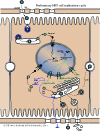Genome amplification versus budding
Neo-synthesized mature nucleocapsids can either be targeted back to the nucleus and amplify the pool of cccDNA, or be targeted to the Endoplasmic reticulum to bud and exit the cell. Envelope protein play a role in the fate of mature nucleocapsids since the cccDNA level is inversely correlated to the level of envelope proteins("Lentz et al. 2011":http://www.ncbi.nlm.nih.gov/pubmed/21900164) Rating=2
Comments
Most viruses have a cellular cycle with at least two phases: first amplification of transcribing genomes, then synthesis of structural proteins for virus exit.
In HBV these two phases have not been clearly identified, and both would depend on mature HBV nucleocapsid. What defines the fate to this particle, toward genome amplification or budding/exit?
-The ammount of L surface protein might regulate this "switch". Possibly the budding/exit is be more efficient than amplification. The latter process would occur early during infection when few structural proteins are synthesized, and would be inhibited once HBV production of S proteins is established. This model would fit with Lentz et al. 2011 Rating=2 conclusions. In case of cell division, the amplification process would be reactivated.
-The phosphorylation of the core C-terminus might be involved, although this is unlikely since several publications reported the need to dephosphorylate the core protein to achieve correct capsid maturation Perlman et al. 2005) Rating=2 (Basagoudanavar et al. 2007).
- The X protein or any other process may stimulate the amplification pathway early during infection. This could be achieved via alternative core protein phosphorylation.


